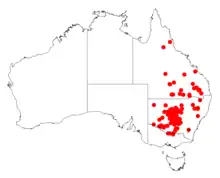Acacia homalophylla
Acacia homalophylla is a small tree found in the eastern half of Australia, where it is known as the yarran.[1] It has also been introduced into India and Pakistan.[2]
| Yarran | |
|---|---|
 | |
| Specimen growing near Nyngan, New South Wales, Australia. | |
| Scientific classification | |
| Kingdom: | Plantae |
| Clade: | Tracheophytes |
| Clade: | Angiosperms |
| Clade: | Eudicots |
| Clade: | Rosids |
| Order: | Fabales |
| Family: | Fabaceae |
| Subfamily: | Caesalpinioideae |
| Clade: | Mimosoid clade |
| Genus: | Acacia |
| Species: | A. homalophylla |
| Binomial name | |
| Acacia homalophylla A. Cunn. ex Benth. | |
 | |
| Occurrence data from AVH | |
| Synonyms | |
| |
Description
Acacia homalophylla has a clean trunk and leafy head, a dark gray, rough bark, narrow, usually straight leaves, and yellow flowers in balls. The leaves are edible and used for fodder.[3] It usually flowers in August–October, sometimes November.
It yields a gum.[4] Its wood (called myall-wood) is durable, fragrant, and dark-colored, and used by the natives for spears.[5]
The tree or shrub can grow to a height of 7 m (23 ft) and has an erect or spreading nabit and is often suckering. It has glabrous branchlets that can be slightly hairy on new growth and are angled at extremities. Like most species of Acacia it has phyllodes rather than true leaves. The evergreen, grey-green phyllodes have a narrowly elliptic or oblanceolate or more or less linear shape and are straight to slightly curved with a length of 4 to 11 cm (1.6 to 4.3 in) and a width of 4 to 7 mm (0.16 to 0.28 in) and have many longitudinal veins that are usually obscure but occasionally with have three or more that are more prominent.[6] The inflorescences occur in groups of one to three in the axils and have sperical flower-heads with a diameter of 4 to 6 mm (0.16 to 0.24 in) and contain 20 to 30 bright yellow coloured flowers. Following flowering firmly papery to thin leathery seed pods form thar are straight and flat with a length of up to 7 cm (2.8 in) and a width of 3 to 7 mm (0.12 to 0.28 in).[6]
Etymology
The name probably refers to the smoothness of the phyllodes, which are flat and often appear veinless. Bentham, when publishing this species, used the spelling omalophylla, which he corrected to 'homalophylla' in his Flora of Australiense in 1864. The former spelling is used by some botanists and authors.[6]
Distribution
It has a scattered distribution through Queensland, New South Wales and Victoria. In New South Wales it is found to the west of Muswellbrook and Emmaville and is often a part of Casuarina cristata, rosewood and box communities growing in brown earthy soils.[6]
See also
References
- "Atlas of living Australia". Archived from the original on 21 December 2014.
- "International Legume Database".
- "Everist, 1969".
- Sturtevant's notes on edible plants. 1919. p. 19.
- Webster's Revised Unabridged Dictionary. 1913.
- "Plantnet". Retrieved 20 December 2014.